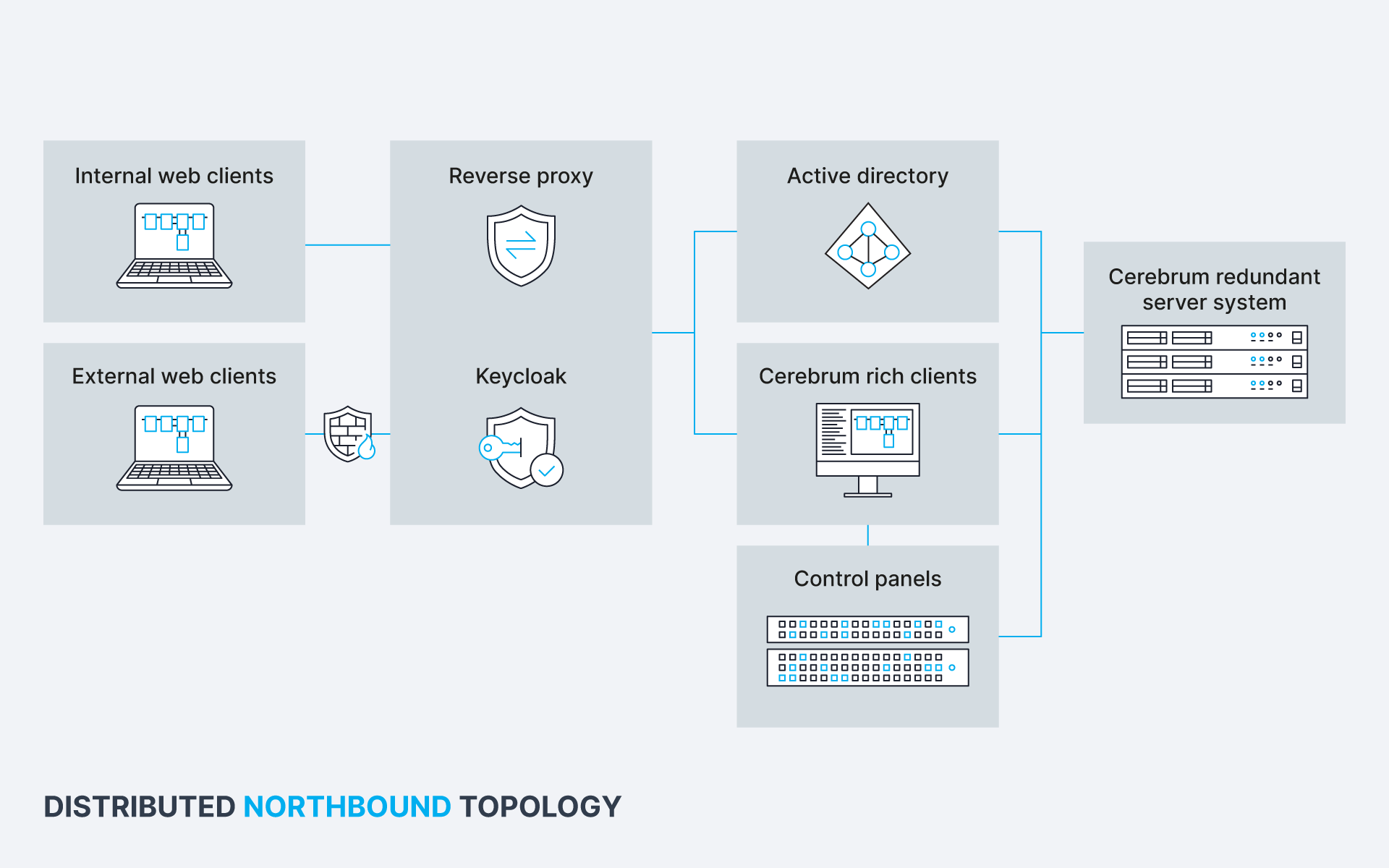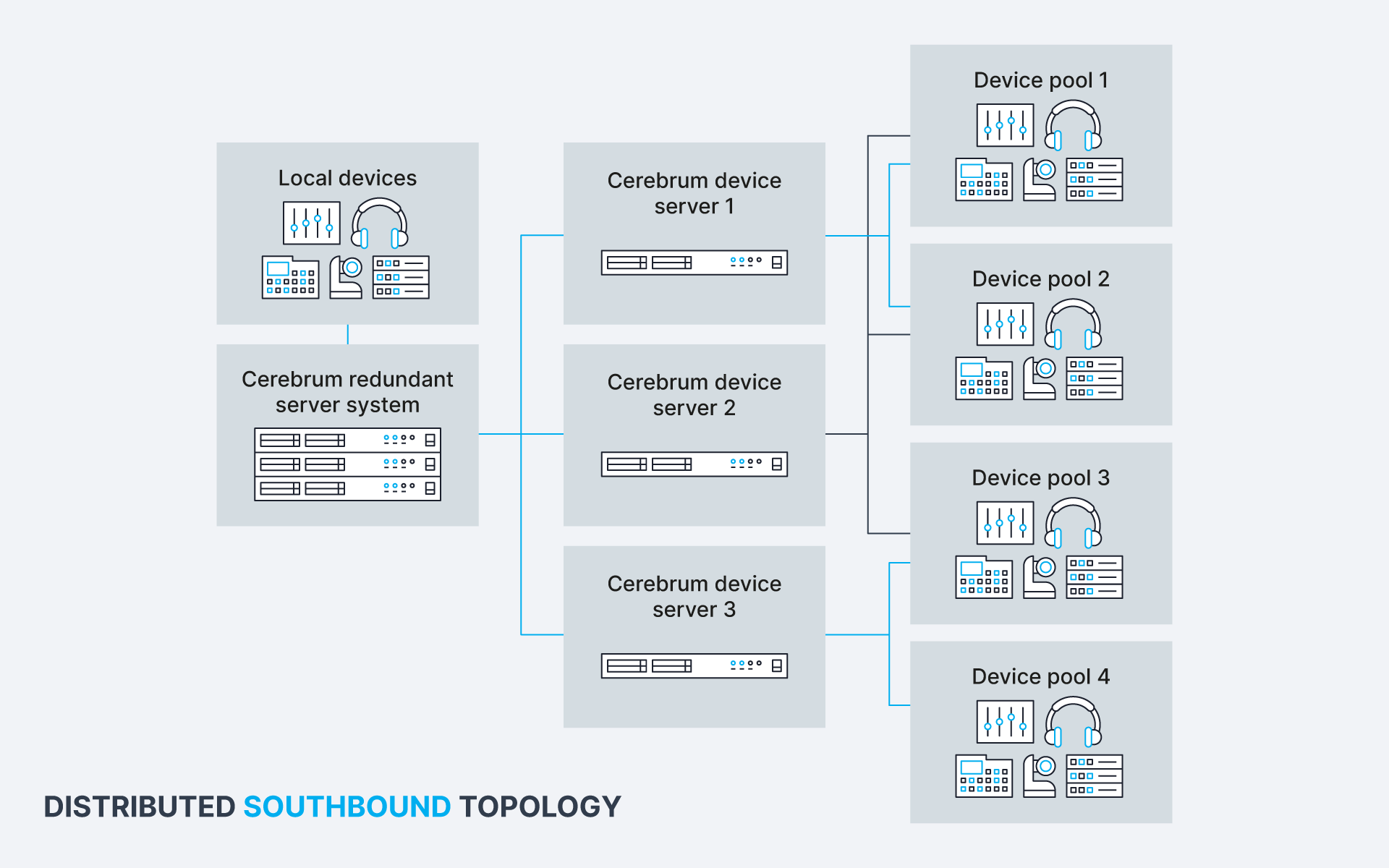As a complete Broadcast Control System (BCS), Cerebrum gives you control over your most critical broadcast operations whether SDI, IP, or hybrid. With customizable interfaces, extensive protocol support, and future-proof security, Cerebrum ensures your production works in harmony.
Solving broadcast complexity with centralized control
- 20 May 2025

Q&A with Dieter Backx, VP Control & Orchestration, Media Infrastructure Solutions at EVS
Picture this: You’re in the middle of a high-stakes live production, everything's running smoothly, until suddenly, a critical device stops responding. The clock is ticking, the pressure is at its highest, and your team is scrambling through multiple control apps, trying to figure out what went wrong. Sounds familiar?
In this Q&A Dieter Backx explains why having a centralized control system like Cerebrum is key to navigating today’s increasingly complex broadcast environments, keeping your operations efficient, scalable, and resilient.
Do broadcasters really need a centralized control system when every device comes with its own control app?
With today’s mix of SDI and IP workflows and the number of devices growing rapidly, production environments are more complex than they’ve ever been. Trying to manage everything through separate control apps can quickly become an operational nightmare!
Those apps don’t talk to each other, so there is a risk of fragmented workflows, inefficiencies, and a lack of overall visibility over your entire system. For example, if a video feed freezes, your multiviewer or router may not even be aware of it. And because most productions involve equipment from various vendors, this kind of disconnect isn’t a rare occurrence.
That’s where a centralized broadcast control system like Cerebrum makes a real difference. Instead of juggling multiple interfaces, it brings everything together into one cohesive environment. Also, device-specific apps only control their own hardware, but Cerebrum goes much further, acting as a unified control layer that orchestrates your entire operation, regardless of brand; it allows you to monitor, manage, and automate across your infrastructure with ease, which means quicker troubleshooting, smoother workflows, and less room for error.
Plus, Cerebrum is truly vendor-agnostic, so you’re not locked into one ecosystem. In fact, many companies (including competitors) request integration with Cerebrum because of how flexible and reliable it is.
Everything accessible to everyone through one interface. Doesn’t that make it more complex for users?
A well-designed control system will simplify operations by adapting to the needs of each user. Cerebrum features dashboards that can be tailored based on roles and responsibilities, meaning each operator sees only the information that matters to them, nothing more, nothing less.
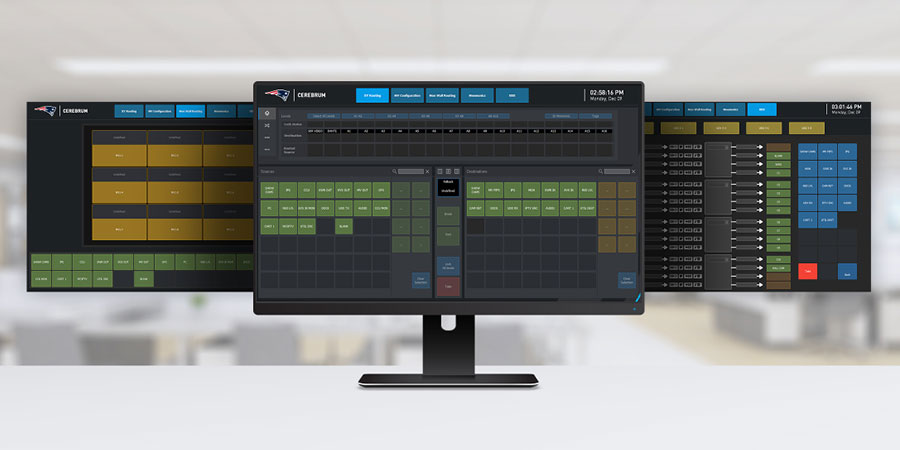
This is ideal for environments with mixed experience levels, like stadiums or university venues where student crews might work alongside seasoned engineers. For example, engineers can create simplified interfaces for less experienced operators, showing only the relevant sources, destinations, and controls. Meanwhile, advanced users retain full access to the system’s capabilities.
We’ve seen this approach work effectively with customers like Gillette Stadium, home of the New England Patriots. Their team uses Cerebrum to support professional-level productions while empowering newer operators to contribute confidently. (Read more about the use of Cerebrum at Gillette Stadium in our case study.)
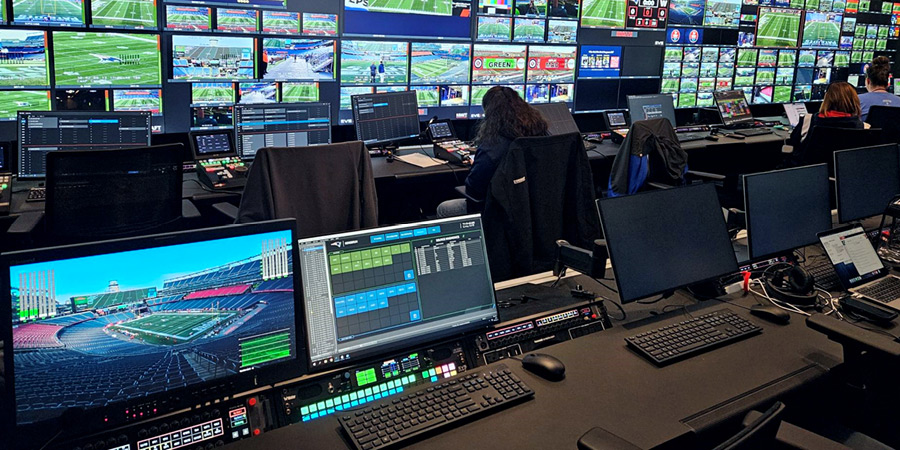
Gillette Stadium in-venue control room, controlled by Cerebrum
On top of that, Cerebrum automates routine tasks behind the scenes. That way, operators can focus on the bigger picture rather than getting stuck managing manual controls. It’s all about reducing complexity where it counts, and enabling better outcomes for teams at every level of experience. Less hassle, a faster learning curve, fewer mistakes, and a smoother production overall.
How does NMOS-only IP routing software compare to a full control system?
While NMOS is an important standard, it only solves part of the challenge. Also, not all devices support it natively. NMOS control software can work well for small-scale setups, but when it comes to 24/7 mission-critical broadcast environments, it just doesn’t offer the scalability, reliability, or redundancy needed to keep everything running smoothly.
Cerebrum, on the other hand, goes far beyond basic discovery and control. It manages other essential broadcast workflows like tally logic, salvos, tielines, and GPI/O. And with NMOS being just one of more than 250 supported protocols (see full list of protocols), it also acts as a protocol translator, ensuring everything works together—no matter the mix of equipment. This gives broadcasters the flexibility and control they need in any environment, without limitations.
If everything is moving to IP, does that mean broadcasters have to discard their legacy SDI equipment?
Transitioning to IP doesn't mean you have to scrap your existing infrastructure overnight! A good broadcast control system will support a hybrid approach, making it possible to migrate to IP at your own pace.
That’s exactly what Cerebrum is designed for. Combining decades of expertise in SDI control, with cutting-edge IP orchestration capabilities, it bridges the gap between legacy gear and modern infrastructure.
It supports a wide range of protocols, allowing engineers to control and configure third-party devices, including older SDI equipment, without worrying about compatibility issues.
Also, from an operator’s perspective, the experience stays consistent. You don’t need to think about what’s running on SDI and what’s on IP—everything is handled through one interface. Besides the manual operation, Cerebrum can automatically take care of cross-demain cross points by using available IP gateways as tie-lines, like Neuron Bridge, to convert SDI to multiple ST2110 essence streams (fan out) and vice versa (fan-in).
And here’s another important point: while many modern devices support NMOS for routing, NMOS alone doesn’t give you full control over device parameters such as changing color corrector settings or swapping audio channels. That’s where a robust control system like Cerebrum comes in, orchestrating both SDI and IP infrastructure for maximum flexibility and efficiency.
Do I really need SDN to optimize my media network or can I manage without it?
It depends on what you want to achieve and whether there is a real technical need for SDN in your setup. In many of today's live production environments, we see a mix of different deployments. Most still operate without SDN, but often have a strong monitoring layer on top- such as Providius NVRT- to gain better visibility across the network.
This aligns with a common driver: as customers transition to IP, they want a clear understanding of how media flows through the network, and possibly even through processing devices. To support this, we offer internal and external tools to provide the needed transparency.
This also means you don’t need to provide a full network management system to control the routing tables on the network fabric. Switches have become very performant in the last decade, and IGMP alone works fine, giving you a good level of flexibility if you’re moving devices around between switches/ports. You basically know that every flow can go everywhere.
In this type of setup, a non-blocking network design is recommended or you have to make sure that you over-provision your network to anticipate future bandwidth increases, for example if moving from HD to UHD.
So, when is SDN truly needed? If you are working in a blocking environment or managing flows across Wide Area Networks (WAN), SDN becomes much more relevant. You want to make sure that bandwidth is guaranteed and protected for each flow. A good example is Euro Media Group's use of Cerebrum SDN for their diPloy mesh-network setups in venues. Here the SDN function is a must-have.
That said, SDN and IGMP-based environments can also work together, for example to create handovers. Ultimately, the right choice depends on your operational priorities. Ask yourself: “what are the benefits of one approach over the other?”, “What is the level of knowledge of my engineers and how much flexibility do we want to give them?", and “Are we prepared to pay the extra cost for the SDN?”.
Systems like Cerebrum gives our customers the flexibility to deploy SDN or not, depending on their technical and operational needs.
How does centralized control improve security and reliability in multi-location broadcast facilities?
When you're running broadcast operations across several sites, security and reliability are critical. A centralized control system should do more than just streamline workflows, it should also provide robust security features to protect against potential vulnerabilities.
Cerebrum is built with that in mind. For starters, it uses multiple clusters that communicate with one another, preventing single points of failure. If something goes down, the rest of the system keeps going—no interruption, no panic.
Access control is another important piece. With Cerebrum, you get centralized user authentication, including Single Sign-On (SSO) and reverse proxy configurations, ensuring that only authorized users can access critical systems, even from outside your main facility.
Additionally, Cerebrum’s SDN-based NATing capabilities enable strict network isolation where needed, providing broadcasters with greater control over data flow and security policies.
Real-time monitoring and automated alerts also give engineers full visibility into system health. Problems can be caught—and solved—before they impact production.
Another aspect is that Cerebrum can connect to multiple NMOS Registry at the same time which for customers that have different business needs can split their setup logically in an easy way – this to split risk and provide more flexibility in maintenance and upgrade windows.
This was implemented in one of our bigger installs at Canal+ in France where they split Production from Master Control from Playout as each of them have different needs and maintenance windows but still relying on one big Cisco network underneath where everything could technically reach each other from a network perspective.
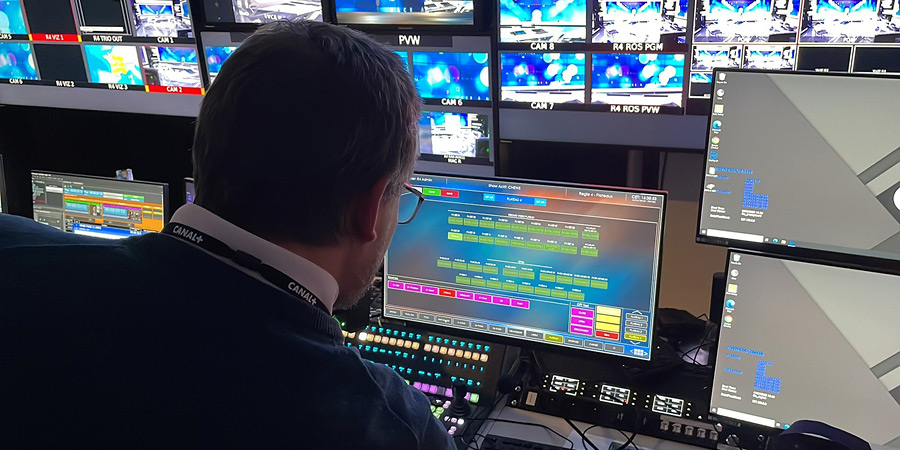
Tailored Cerebrum end-user interface at Canal+
A growing trend in live production is the shift toward multipurpose production control rooms with flexible resource assignment. What part will EVS play in that?
Among the key drivers behind this trend is the need to optimize the total cost of ownership (TCO) of infrastructure investments, but we’re also seeing a growing focus on reducing energy consumption. Although they might not be linked to the same cost center, these goals are closely aligned, and both benefit from more efficient use of production resources.
We often talk about software resources and how we can stop or start them as needed, but if you’re able to optimize your underlying physical components to reach almost a 100% utilization, then you can’t get much better than that!
That’s exactly what EVS is enabling today with Cerebrum. And now with its powerful resource management capabilities, teams can easily monitor which resources are in use at any given moment. Engineers can still take over control but standard users are limited to pre-assigned functions to prevent any interference.
Many of our customers (particularly in North America), have already adopted this approach through the implementation of what we call ‘flex rooms’ that can be adapted for different production tasks, from replay operations to direct cuts via the router, or even voice booths.
A standout example is NBC Sports, which has deployed Cerebrum at its Stamford headquarters. There, flexible workstations have been set up alongside the Venue Control Rooms to provide additional space for operators. These not only support productions in the new Venue Control Rooms but also extend their capabilities to other Stamford Control Rooms, remote OB units, and international productions. Cerebrum plays a central role in enabling this flexibility, offering dynamic panel configurations, flexible naming, and granular user rights management.
This is where you really see the flexibility of Cerebrum shine: allowing engineering teams to reassign control room functions from one production to the next with minimal effort.
Looking ahead, our ongoing mission is to further simplify the user experience and standardize workflows as much as possible. So that even operational staff can be deployed more flexibly, helping broadcasters get more value out of every resource, person, and production.

Dieter brings over 15 years of broadcast industry experience and deep operational expertise to EVS, having played a key role in delivering seamless execution and top-notch service at some of the world’s biggest sporting events. Driven by a strong commitment to customer success, he’s known for translating complex needs into innovative solutions through a collaborative approach, improving both performance and user experience.
